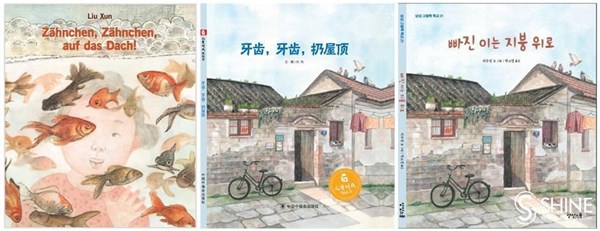今日上海
中国图书走向世界舞台 - 2019年07月26日
Chinese books go global

While foreign picture books imported into China are welcomed by Chinese families, some Chinese picture books are being exported to other countries.
A German version of “Tooth, Tooth, Throw It onto the Roof,” a picture book by Liu Xun, will make its debut at the International Literature Festival Berlin in September, its publisher told Shanghai Daily on Wednesday.
“It’s a new step for China, a young player in the world’s picture book industry, to bring our publications overseas,” said Huang Qian, director of the copyright department of the China Welfare Institute Publishing House, which published the Chinese version.
The book is about a girl who loses a lower front tooth and goes to look for her grandfather to help her throw it onto the roof. In Chinese tradition, throwing the lower teeth onto the roof can help children grow tall. On her way to look for her grandfather, as the book depicts, she experiences a typical Chinese community and people’s everyday lives.
Huang said German publisher Edition Bracklo noticed the book at a fair in Beijing and asked for the authorization to translate and publish a German version.
In 2014, a Korean version was produced after a Korean publisher came across the book at the Shanghai International Children’s Book Fair.
“It attracted the Korean publisher as South Korea has a similar culture with China and its readers can easily resonate with the story,” Huang said. “It was the first time that we realized that there could be a need for our publications in other countries.”
Since then, about 30 picture books from the China Welfare Institute Publishing House have been or are being exported.
The job is sometimes not easy because of the diverse cultural backgrounds of foreign readers.
The Korean version of “Tooth, Tooth, Throw It onto the Roof” was published exactly based on the Chinese version. But to have it better accepted by German readers, the author repainted the cover according to a suggestion from Edition Bracklo.
“The cover painting of the Chinese and Korean versions is a house with a roof, but our German partner said it’s not so easy for German readers to understand the theme and suggested a painting of a girl with a tooth missing,” Huang said.
Huang said such modifications are not rare when exporting books. When the publisher developed the English version of picture book “Home for Chinese New Year,” it changed the original cover picture of huge crowds of people at a railway station, a typical scene in China as people head home for family reunions ahead of the Spring Festival.
“The cover painting of the English version is about a family having dinner on Chinese New Year’s Eve, because our partner said it’s easier for foreigners to understand the topic of Chinese New Year,” said Huang.
Not every export enterprise ends in success. Huang said the publisher failed to reach agreements with some potential partners due to cultural and religious issues. But she also said some markets surprised them by importing books they hadn’t expected.
“We reached an agreement with an Egyptian publishing house last year to publish four books in Arabic,” she said. “To our surprise, one of them was about life in the ice and snow. Maybe the topic is attractive to them just because it’s far away from their life.”
